stop start CHEVROLET KODIAK 2007 User Guide
[x] Cancel search | Manufacturer: CHEVROLET, Model Year: 2007, Model line: KODIAK, Model: CHEVROLET KODIAK 2007Pages: 430, PDF Size: 6.06 MB
Page 123 of 430

Shifting Out of Four-Wheel Low
To shift from Four-Wheel Low to Four-Wheel High
or Two-Wheel High, your vehicle must be
stopped or moving less than 3 mph (5 km/h) with
the transmission in NEUTRAL (N) and the
engine running. The preferred method for shifting
out of Four-Wheel Low is to have your vehicle
moving 1 or 2 mph (1.6 to 3.2 km/h). Turn the knob
to Four-Wheel High or Two-Wheel High. You
must wait for the Four-Wheel High or Two-Wheel
High indicator light to stop flashing and remain
on before shifting the transmission into gear.
Notice:Shifting the transmission into gear
before the Four-Wheel High or Two-Wheel High
indicator light has stopped �ashing could
damage the transfer case. To help avoid
damaging your vehicle, always wait for the
Four-Wheel High or Two-Wheel High indicator
light to stop �ashing before shifting the
transmission into gear.
If the knob is turned to Four-Wheel High or
Two-Wheel High while your vehicle is in gear and/or
moving, the Four-Wheel High or Two-Wheel high
indicator light flashes for 30 seconds. It will not
complete the shift unless your vehicle is moving
less than 3 mph (5 km/h) with the transmission in
NEUTRAL (N).
Shifting Into NEUTRAL
Before shifting the transfer case to NEUTRAL, first
make sure the vehicle is parked so that it will
not roll.
1. Set the parking brake.
2. Start the vehicle.
3. Put the transmission in NEUTRAL (N).
4. Shift the transfer case to Two-Wheel High.
5. Turn the transfer case knob all of the way past
Four-Wheel Low and hold it there for a
minimum of 10 seconds. The NEUTRAL
indicator light comes on.
6. Shift the transmission to REVERSE (R) for
one second, then shift the transmission to
DRIVE (D) for one second.
7. Turn the ignition to OFF.
8. Place the transmission shift lever in
PARK. (P).
9. Turn the ignition to LOCK.
123
Page 145 of 430

Windshield Wipers
You control the
windshield wipers
by turning the
band with the wiper
symbol on it.
9(Off):Turn the band on the lever to this
symbol to turn off the windshield wipers.
8(Mist):For a single wiping cycle, turn the band
to this symbol. Hold it there until the wipers start,
then let go. The wipers will stop after one cycle. If
you want more cycles, hold the band on mist
longer.
You can set the wiper speed for a long or short
delay between wipes. This can be very useful in
light rain or snow. Turn the band to select the delay
time. The farther the band is turned upward, the
longer the delay will be. The farther the band is
turned downward, the shorter the delay will be.For steady wiping at low speed, turn the band
toward you to the first solid band below the
delay settings.
For high-speed wiping, turn the band farther, to the
last solid band below the delay settings. To stop the
wipers, move the band to off.
Be sure to clear ice and snow from the wiper
blades before using them. If they are frozen to the
windshield, carefully loosen or thaw them. If
your blades do become worn or damaged, get
new blades or blade inserts. For more information,
seeWindshield Wiper Blade Replacement on
page 316.
Heavy snow or ice can overload your wipers.
The windshield wiper motor is protected
from overload by a circuit breaker and a fuse. If
the motor overheats due to heavy snow or ice the
wiper will stop until the motor cools. Although
the circuit is protected from electrical overload,
overload due to heavy snow or ice may cause
wiper linkage damage. Always clear ice and heavy
snow from the windshield before using your
windshield wipers.
145
Page 170 of 430

The brake system warning light may come on, and
the warning tone may sound, when you are
turning and braking at the same time. This is
normal. See “Hydraulic Brake Systems” under
Braking on page 210.
This light is located
above the climate
controls in the center of
the instrument panel.
If the service brakes soon warning light comes on,
it means there may be something wrong in the
brake system.
When this light comes on, you will also hear a
warning tone. Have the system repaired
immediately.Both of these lights should come on briefly every
time you start your engine. If they do not come
on then, have them fixed so they will be ready to
warn you if there is a problem. If one or both
of these warning lights stay on after you start the
engine, there could be a brake problem. Have
your brake system inspected right away.
If one or both of these lights come on while you
are driving, pull off the road and stop carefully. You
may notice that the pedal is harder to push, or
the pedal may go closer to the floor. It may take
longer to stop. If this light is still on, have the
vehicle towed for service. SeeTowing Your
Vehicle on page 241. See “Hydraulic Brake
Systems” underBraking on page 210for further
information.
170
Page 171 of 430
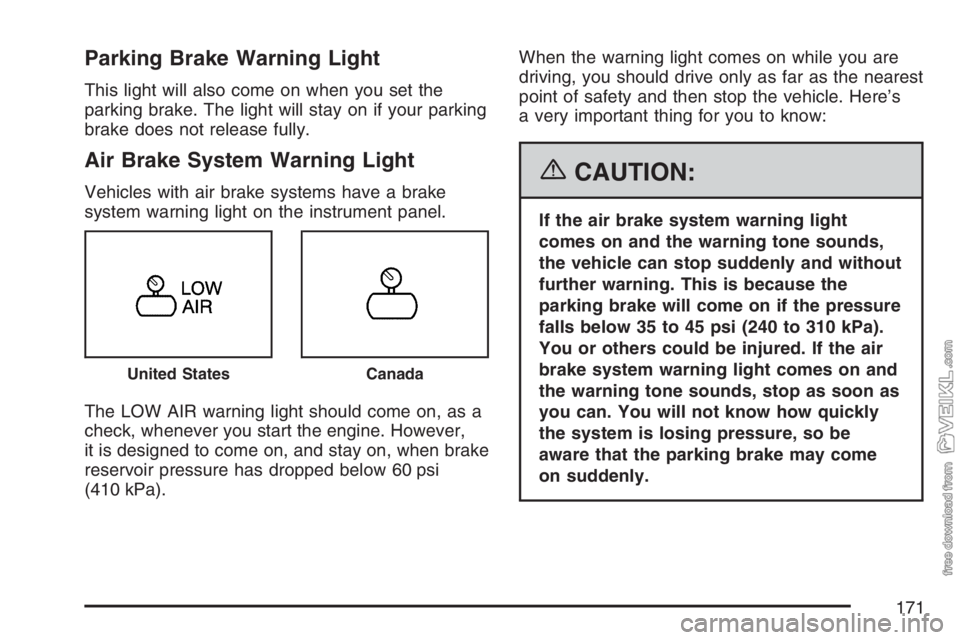
Parking Brake Warning Light
This light will also come on when you set the
parking brake. The light will stay on if your parking
brake does not release fully.
Air Brake System Warning Light
Vehicles with air brake systems have a brake
system warning light on the instrument panel.
The LOW AIR warning light should come on, as a
check, whenever you start the engine. However,
it is designed to come on, and stay on, when brake
reservoir pressure has dropped below 60 psi
(410 kPa).When the warning light comes on while you are
driving, you should drive only as far as the nearest
point of safety and then stop the vehicle. Here’s
a very important thing for you to know:{CAUTION:
If the air brake system warning light
comes on and the warning tone sounds,
the vehicle can stop suddenly and without
further warning. This is because the
parking brake will come on if the pressure
falls below 35 to 45 psi (240 to 310 kPa).
You or others could be injured. If the air
brake system warning light comes on and
the warning tone sounds, stop as soon as
you can. You will not know how quickly
the system is losing pressure, so be
aware that the parking brake may come
on suddenly.
United StatesCanada
171
Page 173 of 430
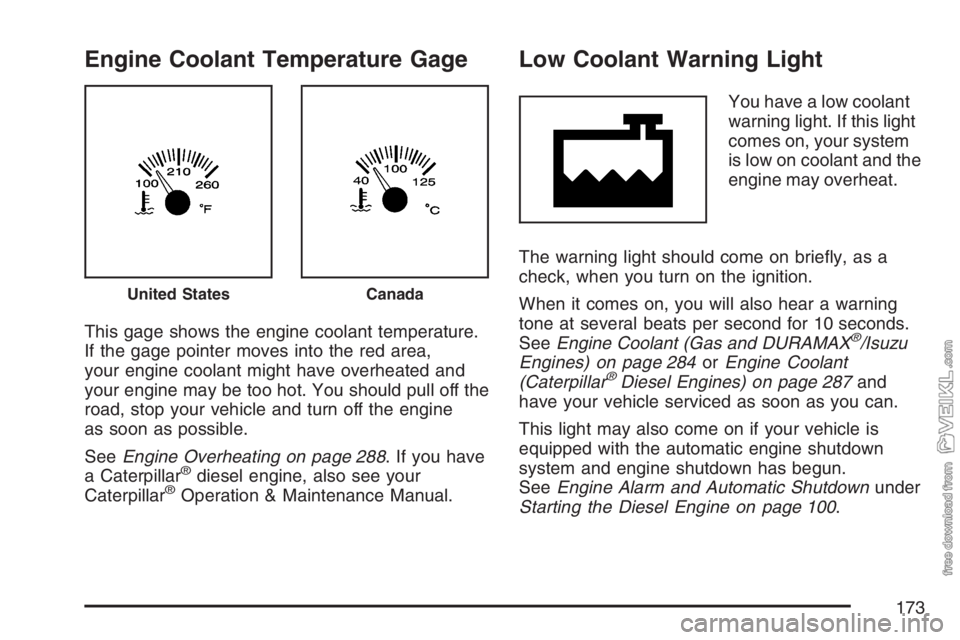
Engine Coolant Temperature Gage
This gage shows the engine coolant temperature.
If the gage pointer moves into the red area,
your engine coolant might have overheated and
your engine may be too hot. You should pull off the
road, stop your vehicle and turn off the engine
as soon as possible.
SeeEngine Overheating on page 288. If you have
a Caterpillar
®diesel engine, also see your
Caterpillar®Operation & Maintenance Manual.
Low Coolant Warning Light
You have a low coolant
warning light. If this light
comes on, your system
is low on coolant and the
engine may overheat.
The warning light should come on briefly, as a
check, when you turn on the ignition.
When it comes on, you will also hear a warning
tone at several beats per second for 10 seconds.
SeeEngine Coolant (Gas and DURAMAX
®/Isuzu
Engines) on page 284orEngine Coolant
(Caterpillar
®Diesel Engines) on page 287and
have your vehicle serviced as soon as you can.
This light may also come on if your vehicle is
equipped with the automatic engine shutdown
system and engine shutdown has begun.
SeeEngine Alarm and Automatic Shutdownunder
Starting the Diesel Engine on page 100.
United StatesCanada
173
Page 198 of 430

Playing a CD
Insert a CD partway into the slot, label side up.
The player pulls it in and the CD should begin
playing. CD appears on the display. If you want to
insert a CD with the ignition off, first press the
eject button or the RCL knob.
If you insert a CD with the radio off and the
ignition on, it starts to play.
If the ignition or radio is turned off, with a CD in
the player, it stays in the player. When the ignition
or radio is turned on, the CD starts playing
where it stopped, if it was the last selected audio
source.
As each new track starts to play, the track number
appears on the display.The CD player can play the smaller 3 inch (8 cm)
single CDs with an adapter ring. Full-size CDs
and the smaller CDs are loaded in the same
manner.
If playing a CD-R, the sound quality may be
reduced due to CD-R quality, the method of
recording, the quality of the music that has been
recorded, and the way the CD-R has been
handled. There may be an increase in skipping,
difficulty in finding tracks, and/or difficulty in loading
and ejecting. If these problems occur, check the
bottom surface of the CD. If the surface of the CD
is damaged, such as cracked, broken, or
scratched, the CD will not play properly. If the
surface of the CD is soiled, seeCare of Your CDs
on page 203for more information.
If there is no apparent damage, try a known
good CD.
198
Page 212 of 430
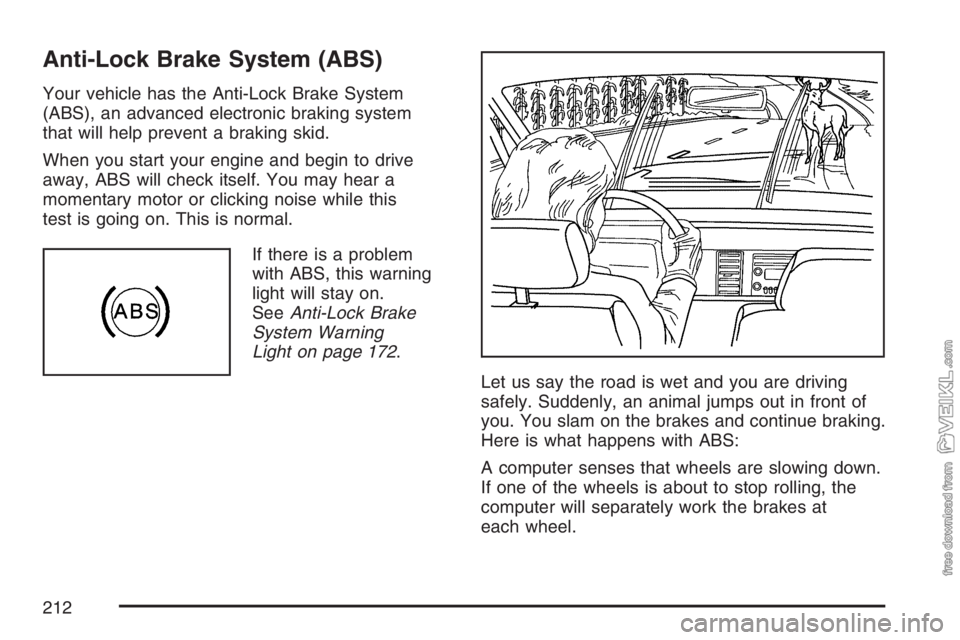
Anti-Lock Brake System (ABS)
Your vehicle has the Anti-Lock Brake System
(ABS), an advanced electronic braking system
that will help prevent a braking skid.
When you start your engine and begin to drive
away, ABS will check itself. You may hear a
momentary motor or clicking noise while this
test is going on. This is normal.
If there is a problem
with ABS, this warning
light will stay on.
SeeAnti-Lock Brake
System Warning
Light on page 172.
Let us say the road is wet and you are driving
safely. Suddenly, an animal jumps out in front of
you. You slam on the brakes and continue braking.
Here is what happens with ABS:
A computer senses that wheels are slowing down.
If one of the wheels is about to stop rolling, the
computer will separately work the brakes at
each wheel.
212
Page 224 of 430
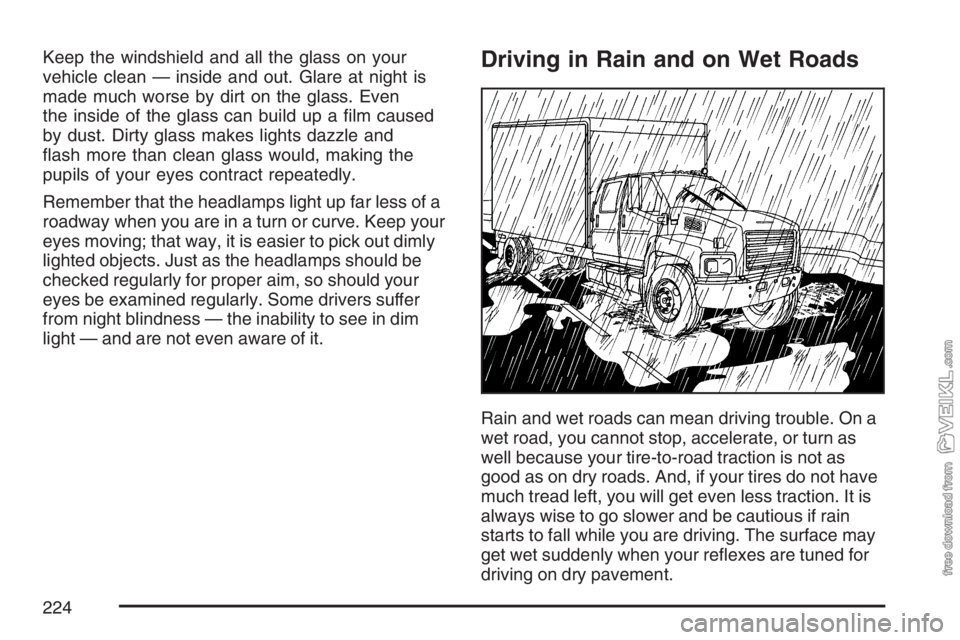
Keep the windshield and all the glass on your
vehicle clean — inside and out. Glare at night is
made much worse by dirt on the glass. Even
the inside of the glass can build up a film caused
by dust. Dirty glass makes lights dazzle and
flash more than clean glass would, making the
pupils of your eyes contract repeatedly.
Remember that the headlamps light up far less of a
roadway when you are in a turn or curve. Keep your
eyes moving; that way, it is easier to pick out dimly
lighted objects. Just as the headlamps should be
checked regularly for proper aim, so should your
eyes be examined regularly. Some drivers suffer
from night blindness — the inability to see in dim
light — and are not even aware of it.Driving in Rain and on Wet Roads
Rain and wet roads can mean driving trouble. On a
wet road, you cannot stop, accelerate, or turn as
well because your tire-to-road traction is not as
good as on dry roads. And, if your tires do not have
much tread left, you will get even less traction. It is
always wise to go slower and be cautious if rain
starts to fall while you are driving. The surface may
get wet suddenly when your reflexes are tuned for
driving on dry pavement.
224
Page 225 of 430
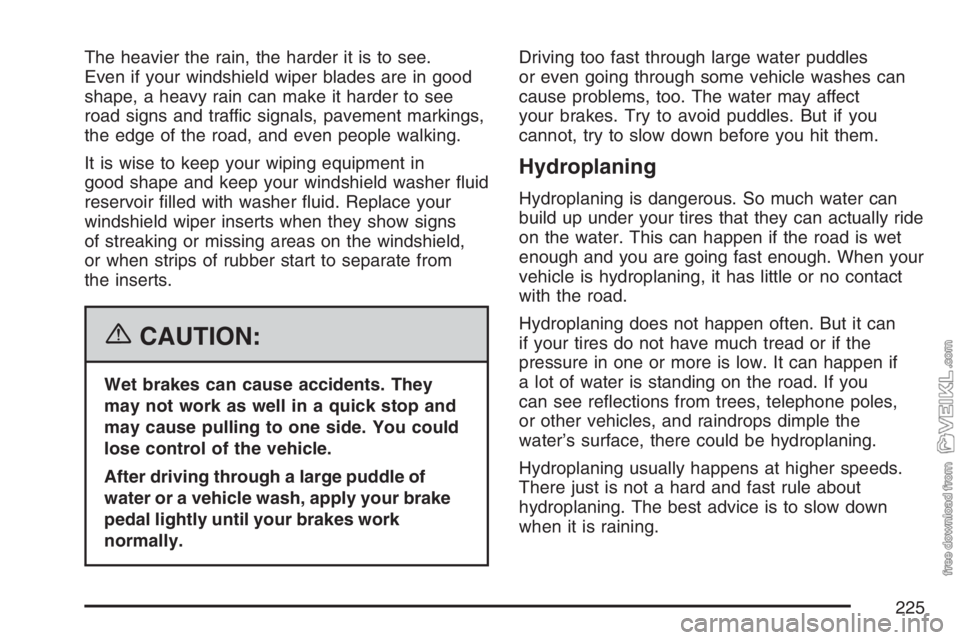
The heavier the rain, the harder it is to see.
Even if your windshield wiper blades are in good
shape, a heavy rain can make it harder to see
road signs and traffic signals, pavement markings,
the edge of the road, and even people walking.
It is wise to keep your wiping equipment in
good shape and keep your windshield washer fluid
reservoir filled with washer fluid. Replace your
windshield wiper inserts when they show signs
of streaking or missing areas on the windshield,
or when strips of rubber start to separate from
the inserts.
{CAUTION:
Wet brakes can cause accidents. They
may not work as well in a quick stop and
may cause pulling to one side. You could
lose control of the vehicle.
After driving through a large puddle of
water or a vehicle wash, apply your brake
pedal lightly until your brakes work
normally.Driving too fast through large water puddles
or even going through some vehicle washes can
cause problems, too. The water may affect
your brakes. Try to avoid puddles. But if you
cannot, try to slow down before you hit them.
Hydroplaning
Hydroplaning is dangerous. So much water can
build up under your tires that they can actually ride
on the water. This can happen if the road is wet
enough and you are going fast enough. When your
vehicle is hydroplaning, it has little or no contact
with the road.
Hydroplaning does not happen often. But it can
if your tires do not have much tread or if the
pressure in one or more is low. It can happen if
a lot of water is standing on the road. If you
can see reflections from trees, telephone poles,
or other vehicles, and raindrops dimple the
water’s surface, there could be hydroplaning.
Hydroplaning usually happens at higher speeds.
There just is not a hard and fast rule about
hydroplaning. The best advice is to slow down
when it is raining.
225
Page 254 of 430
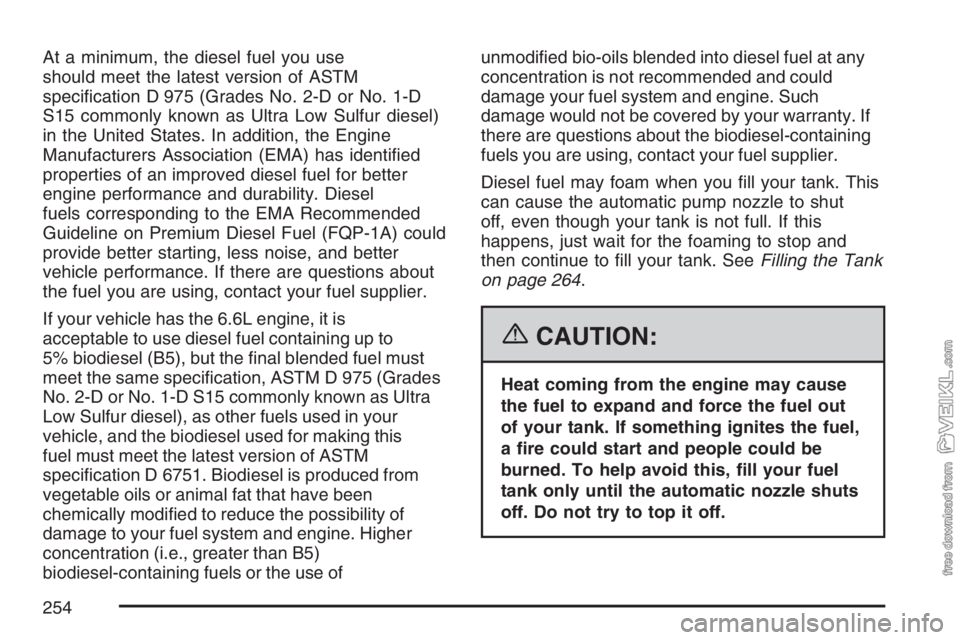
At a minimum, the diesel fuel you use
should meet the latest version of ASTM
specification D 975 (Grades No. 2-D or No. 1-D
S15 commonly known as Ultra Low Sulfur diesel)
in the United States. In addition, the Engine
Manufacturers Association (EMA) has identified
properties of an improved diesel fuel for better
engine performance and durability. Diesel
fuels corresponding to the EMA Recommended
Guideline on Premium Diesel Fuel (FQP-1A) could
provide better starting, less noise, and better
vehicle performance. If there are questions about
the fuel you are using, contact your fuel supplier.
If your vehicle has the 6.6L engine, it is
acceptable to use diesel fuel containing up to
5% biodiesel (B5), but the final blended fuel must
meet the same specification, ASTM D 975 (Grades
No. 2-D or No. 1-D S15 commonly known as Ultra
Low Sulfur diesel), as other fuels used in your
vehicle, and the biodiesel used for making this
fuel must meet the latest version of ASTM
specification D 6751. Biodiesel is produced from
vegetable oils or animal fat that have been
chemically modified to reduce the possibility of
damage to your fuel system and engine. Higher
concentration (i.e., greater than B5)
biodiesel-containing fuels or the use ofunmodified bio-oils blended into diesel fuel at any
concentration is not recommended and could
damage your fuel system and engine. Such
damage would not be covered by your warranty. If
there are questions about the biodiesel-containing
fuels you are using, contact your fuel supplier.
Diesel fuel may foam when you fill your tank. This
can cause the automatic pump nozzle to shut
off, even though your tank is not full. If this
happens, just wait for the foaming to stop and
then continue to fill your tank. SeeFilling the Tank
on page 264.
{CAUTION:
Heat coming from the engine may cause
the fuel to expand and force the fuel out
of your tank. If something ignites the fuel,
a �re could start and people could be
burned. To help avoid this, �ll your fuel
tank only until the automatic nozzle shuts
off. Do not try to top it off.
254